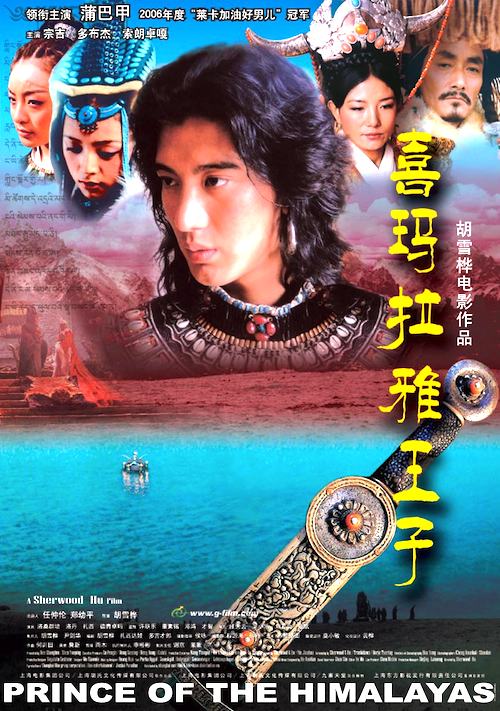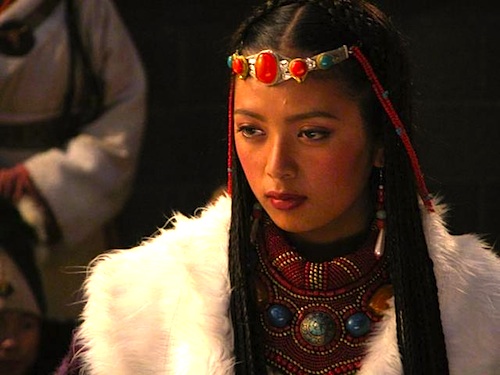 By Joe Bendel. Shakespeare famously wrote in As You Like It: “all the world’s a stage.” That includes the “Roof of the World” as well. In an act of sheer cinematic bravura, Sherwood Hu moves the Danish tragedy to the high Tibetan mountains, taking invigorating liberties with the Shakespeare play in the process. Appropriately, Hu’s The Prince of the Himalayas (trailer here), will have its premiere American theatrical engagement exclusively at the Rubin Museum of Art (home to the largest collection of Himalayan art in the West and some of the City’s finest film and jazz programming), starting this Friday.
By Joe Bendel. Shakespeare famously wrote in As You Like It: “all the world’s a stage.” That includes the “Roof of the World” as well. In an act of sheer cinematic bravura, Sherwood Hu moves the Danish tragedy to the high Tibetan mountains, taking invigorating liberties with the Shakespeare play in the process. Appropriately, Hu’s The Prince of the Himalayas (trailer here), will have its premiere American theatrical engagement exclusively at the Rubin Museum of Art (home to the largest collection of Himalayan art in the West and some of the City’s finest film and jazz programming), starting this Friday.
Returning from his studies in Persia, Prince Lhamoklodan is distressed to learn he just missed his father’s funeral. He is also put-off by the news his uncle Kulo-ngam will become the crown-regent by marrying his mother Namn. Indeed, one ceremony closely follows the other, as his school chum Horshu observes. However, it is the ghost of his father who confirms Lhamoklodan’s suspicions, setting him on a bloody course of vengeance.
So far, so Shakespearean. Yet Hu has several surprises in store for viewers, most notably his decision to make the Himalayan Gertrude and especially its Claudius, the sympathetic core of the film. We learn rather early Kulo-ngam always loved Namn, but his not so dearly departed older brother cruelly intervened. As a result, Lhamoklodan comes across as one of the harsher, more spiteful Hamlets ever seen on-screen. Conversely, the ethereally beautiful Osaluyang is one of the most heartbreaking Ophelias. She also reaches rare heights of madness in a role often required to discretely slip into the water off-screen or off-stage in many conventional productions.
Borrowing elements from Macbeth and Sophocles, Hu’s adaptation of Shakespeare is inspired, but hardly slavish in its faithfulness. He arguably remains true to the spirit of the original play (although you probably would not want to argue the point with Harold Bloom). Without question, though, the Tibetan mountains and tundra must be the grandest, most expansive setting for any staging of Hamlet. If there is any misstep in the Himalayan Prince, it is that of over-scoring. The vast spaces of the Jiabo kingdom call out for eerie silence rather than prestige picture orchestrations.

Hu is a bold, slightly reckless filmmaker, who gets some powerful performances from his cast. Purba Rgyal is appropriately fierce and charismatic as Lhamoklodan, but Dobrgyal gives the film its soul as the acutely conflicted Kulo-ngam. His scenes with Zomskyid’s Namn/Gertrude are achingly touching, as is the exquisitely vulnerable performance of Sonamdolgar as Odsaluyang.
While Hu’s Prince often rather abruptly segues from scene to scene, his breakneck pacing wraps up Shakespeare’s longest play in an impressively economical 108 minutes. Purists might take issue with his alterations to the time honored tale (alas, poor Yorick did not make the cut). However, it is worth noting that Kurosawa’s masterpiece Throne of Blood yielded probably the greatest death scene in motion picture history by revising the ending of Macbeth.
Granted, Hu’s Prince is not quite at that level, but not for a lack of ambition and vision. Indeed, it is a richly produced period piece, considerably superior to most of the supposed Oscar bait coyly dropping in and out of theaters over the next two weeks. Grand in scope and enormously satisfying, it is highly recommended when it screens at the Rubin Museum in New York over the course of ten non-sequential days, beginning the Friday (12/23) through Saturday, January 14th. Check their website for specific dates and times, as well as information about their world-class exhibits.
Posted on December 22nd, 2011 at 11:16am.